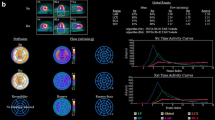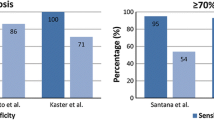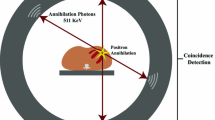Abstract
Several tracer approaches have been proposed for the assessment of myocardial perfusion with positron emission tomography (PET) in the clinical setting. These include nitrogen-13 (13N) labelled ammonia, oxygen-15 (15O) labelled water, rubidium-82 (82Rb) and potassium-38 (38K). These tracers require a local cyclotron for production, except for 82Rb which may be delivered directly to the patient from an on-site generator. There are two specific clinical applications of PET that have been proposed for the evaluation of patients with coronary artery disease (CAD) [1-3]. The first is the noninvasive detection of CAD and estimation of the severity of the disease. This is performed using a PET perfusion agent at rest and during pharmacologic vasodilation. A unique application of PET is the noninvasive calculation of absolute regional myocardial perfusion at rest and during vasodilation in humans using [15O]water or [13N]ammonia. However, most centers rely on the qualitative interpretation of 82Rb or [13N]ammonia images for the detection of CAD and the assessment of its severity. The second clinical application of PET is the assessment of myocardial viability in CAD patients with left ventricular dysfunction. The most common approach is to determine whether metabolic activity assessed by 2-[18F]fluoro-2-deoxy-D-glucose ([18F]FDG) is preserved in regions with reduced perfusion, thus indicating tissue viability.
Access this chapter
Tax calculation will be finalised at checkout
Purchases are for personal use only
Preview
Unable to display preview. Download preview PDF.
Similar content being viewed by others
References
Bonow RO, Berman DS, Gibbons RJ, et al. Cardiac positron emission tomography: a report for health professionals from the committee on advanced cardiac imaging and technology of the council on clinical cardiology, American Heart Association. 1991; 84: 447–54.
Schelbert H, et al. Position statement: clinical use of cardiac positron emission tomography. Position paper of the cardiovascular council of the Society of Nuclear Medicine. J Nucl Med 1993; 34: 1385–88.
Ritchie JL, Bateman TM, Bonow RO, et al. Guidelines for clinical use of cardiac radionuclide imaging: report of the American College of Cardiology/American Heart Association task force on assessment of diagnostic and therapeutic cardiovascular procedures (Committee on Radionuclide Imaging), developed in collaboration with the American Society of Nuclear Cardiology. J Am Coll Cardiol 1995; 25: 521–47.
Schelbert H, Wisenberg G, Phelps ME, et al. Non-invasive assessment of coronary stenoses by myocardial imaging during pharmacologie coronary vasodilation. VI. Detection of coronary artery disease in man with intravenous N-13 ammonia and positron computed tomography. Am J Cardiol 1982; 49: 1197–207.
Demer LL, Gould KL, Goldstein RA, et al. Assessment of coronary artery disease severity by positron emission tomography. Comparison with quantitative arteriography in 193 patients. Circulation 1989; 79: 825–35.
Tamaki N, Yonekura Y, Senda M, et al. Value and limitation of stress thallium-201 single photon emission computed tomography: comparison with nitrogen-13 ammonia positron tomography. J Nucl Med 1988; 29: 1181–88.
Go R, Marwick T, McIntyre W, et al. A prospective comparison of rubidium-82 PET and thallium-201 SPECT myocardial perfusion imaging utilizing a single dipyridamole stress in the diagnosis of coronary artery disease. J Nucl Med 1990; 31: 1899–905.
Stewart R, Schwaiger M, Molina E, et al. Comparison of rubidium-82 positron emission tomography and thallium-201 SPECT imaging for detection of coronary artery disease. Am J Cardiol 1981; 48: 1077–85.
Patterson RE, Eisner RL, Horowitz SF. Comparison of cost-effectiveness and utility of exercise ECG, single photon emission computed tomography, positron emission tomography, and coronary angiography for diagnosis of coronary artery disease. Circulation 1995; 91: 54–65.
Bergmann SR, Fox KAA, Rand AL, et al. Quantification of regional myocardial blood flow in vivo with H215O. Circulation 1984; 70: 724–33.
Bergmann SR, Herrero P, Markham J, Weinheimer CJ, Walsh MN. Non-invasive quantification of myocardial blood flow in human subjects with O-15 labelled water and positron emission tomography. J Am Coll Cardiol 1989; 14: 639–52.
Araujo LI, Lammertsma AA, Rhodes CG, et al. Non-invasive quantification of regional myocardial blood flow in normal volunteers and patients with coronary artery disease using oxygen-15 labeled carbon dioxide inhalation and positron emission tomography. Circulation 1991; 83: 875–85.
Bol A, Melin JA, Vanoverschelde J-L, et al. Direct comparison of [13N]ammonia and [15O] water estimates of perfusion with quantification of regional myocardial blood flow by microspheres. Circulation 1993; 87: 512–25.
Muzik O, Beanlands RSB, Hutchins GD, Mangner TJ, Nguyen N, Schwaiger M. Validation of nitrogen-13 ammonia tracer kinetic model for quantification of myocardial blood flow using PET. J Nucl Med 1993; 34: 83–91.
Kuhle WG, Porenta G, Huang SC, et al. Quantification of regional myocardial blood flow using 13N-ammonia and reoriented dynamic positron emission tomographic imaging. Circulation 1992; 86: 1004–17.
Herrero P, Markham J, Shelton ME, Bergmann SR. Implementation and evaluation of a two-compartment model for quantification of myocardial perfusion with rubidium-82 and positron emission tomography. Circ Res 1992; 70: 496–507.
Henes CG, Bergmann SR, Perez JE, Sobel BE, Geltman EM. The time course of restoration of nutritive perfusion, myocardial oxygen consumption, and regional function after coronary thrombolysis. Cor Art Dis 1990; 1: 687–96.
Czernin J, Porenta G, Brunken R, et al. Regional blood flow, oxidative metabolism, and glucose utilization in patients with recent myocardial infarction. Circulation 1993; 88: 884–95.
Vanoverschelde J-L, Melin JA, Bol A, et al. Regional oxidative metabolism in patients after recovery from reperfused anterior myocardial infarction. Circulation 1992; 85: 9–21.
Gewirtz H, Fischman Ai, Abraham S, Gilson M, Strauss HW, Alpert NM. Positron emission tomographic measurements of absolute regional myocardial blood flow permits identification of non-viable myocardium in patients with chronic myocardial infarction. J Am Coll Cardiol 1994; 23: 851–59.
Piérard LA, DeLandsheere CM, Berthe C, Rigo P, Kulbertus HE. Identification of viable myocardium by echocardiography during dobutamine infusion in patients with myocardial infarction after thrombolytic therapy: comparison with positron emission tomography. J Am Coll Cardiol 1990; 15: 1021–31.
Piérard LA, DeLandsheere CM, Berthe C, Rigo P, Kulbertus HE. Identification of viable myocardium by echocardiography during dobutamine infusion in patients with myocardial infarction after thrombolytic therapy: comparison with positron emission tomography. J Am Coll Cardiol 1990; 15: 1021–31.
Piérard LA, DeLandsheere CM, Berthe C, Rigo P, Kulbertus HE. Identification of viable myocardium by echocardiography during dobutamine infusion in patients with myocardial infarction after thrombolytic therapy: comparison with positron emission tomography. J Am Coll Cardiol 1990; 15: 1021–31.
Wijns W, Vanoverschelde J-L, Gerber B, et al. Evidence that myocardial stunning occurs in humans following unstable angina. J Am Coll Cardiol 1995: 427A.
Rahimtoola SH. The hibernating myocardium. Am Heart J 1989; 117: 211–21.
Vanoverschelde J-L, Wijns W, Depré C, et al. Mechanisms of chronic regional postischemic dysfunction in humans: new insights from the study of non-infarcted collateral dependent myocardium. Circulation 1993; 87: 1513–23.
Shen Y-T, Vatner SF. Mechanism of impaired myocardial function during progressive coronary stenosis in conscious pigs: hibernation versus stunning. Circ Res 1995; 76: 479–88.
Parodi O, Schelbert HR, Schwaiger M, Hansen H, Selin C, Hoffman EJ. Cardiac emission computed tomography: underestimation of regional tracer concentrations due to wall motion abnormalities. J Comput Assist Tomography 1984; 8: 1083–92.
Gould KL, Lipscomb K, Hamilton GW. A physiologic basis for assessing critical coronary stenosis: instantaneaous flow response and regional distribution during coronary hyperemia as measures of coronary flow reserve. Am J Cardiol 1974; 33: 87–94.
Gould KL. Non-invasive assessment of coronary stenoses by myocardial imaging during coronary vasodilation, I: physiologic principles and experimental validation. Am J Cardiol 1978; 41: 267–78.
Hoffman JIE. Maximal coronary flow and the concept of coronary vascular reserve. Circulation 1984; 70: 153–59.
Klocke FJ. Measurements of coronary flow reserve: defining pathophysiology versus making decisions about patient care. Circulation 1987; 76: 1183–89.
De Silva R, Camici PG. Role of positron emission tomography in the investigation of human coronary circulatory function. Cardiovasc Res 1994; 28: 1595–1612.
Glover DK, Ruiz M, Edwards NC, et al. Comparison between 201TI and 99mTc sestamibi uptake during adenosine-induced vasodilation as a function of coronary stenosis severity. Circulation 1995; 91: 813–20.
Camici P, Chiriatti G, Lorenzoni R, et al. Coronary vasodilation is impaired in both hypertrophied and non-hypertrophied myocardium of patients with hypertrophie cardiomyopathy: a study with nitrogen-13 ammonia and positron emission tomography. J Am Coll Cardiol 1991; 17: 879–86.
Sambuceti G, Parodi O, Marcassa C, et al. Alteration in regulation of myocardial blood flow in one vessel coronary artery disease determined by positron emission tomography. Am J Cardiol 1993; 72: 538–43.
Chan SY, Brunken RC, Czemin J, et al. Comparison of maximal myocardial blood flow during adenosine infusion with that of intravenous dipyridamole in normal men. J Am Coll Cardiol 1992; 20: 979–85.
Muzik O, Beanlands R, Wolfe E, Hutchins GD, Schwaiger M. Automated region definition for cardiac Nitrogen-13-ammonia PET imaging. J Nucl Med 1993; 34: 336–44.
Czemin J, Muller P, Chan S, et al. Influence of age and haemodynamics on myocardial blood flow and flow reserve. Circulation 1993; 88: 62–9.
Geltman EM, Henes CG, Senneff MJ, Sobel BE, Bergmann SR. Increased myocardial perfusion at rest and diminished perfusion reserve in patients with angina and angiographically normal coronary arteries. J Am Coll Cardiol 1990; 16: 586–95.
Merlet P, Mazoyer B, Hittinger L, et al. Assessment of coronary reserve in man: comparison between positron emission tomography with oxygen-15 labelled water and intracoronary Doppler technique. J Nucl Med 1993; 34: 1899–1904.
Uren NG, Camici PG, Wijns W, et al. The effect of ageing on coronary flow reserve in man. Circulation 1993; 88: 1–171.
Radvan J, Camici PG, Marwick T, Boyd H, Sheridan DJ. Physiological hypertrophy does not affect coronary flow reserve in man. Circulation 1993; 88: I - 214.
Senneff MJ, Geltman EM, Bergmann SR, Hartmann J. Non-invasive delineation of the effects of moderate ageing on myocardial perfusion. J Nucl Med 1991; 32: 2037–42.
Uren NG, Melin JA, De Bruyne B, Wijns W, Baudhuin T, Camici PG. Myocardial blood flow as a function of coronary stenosis severity in man. N Engl J Med 1994; 330: 1782–88.
Beanlands RSB, Muzik O, Sutor R, et al. Noninvasive determination of regioal perfusion reserve in coronary artery disease using N-13 ammonia PET. J Nuc Med 1992; 33: 826.
Di Carli M, Czernin J, Sherman T, et al. Relationship between stenosis severity, hyperemic blood flow, flow reserve, and coronary resistance in CAD patients. Circulation 1993; 88: I - 647.
Goldstein RA, Kirkeeide RL, Demer LL, et al. Relation between geometric dimensions of coronary artery stenoses and myocardial perfusion reserve in man. J Clin Invest 1987; 79: 1473–78.
Picano E, Parodi E, Lattanzi F, et al. Assessment of anatomic and physiologic severity of single vessel coronary artery lesions by dipyridamole echocardiography: comparison with positron emission tomography and quantitative arteriography. Circulation 1994; 89: 753–61.
Uren NG, Crake T, Lefroy DC, De Silva R, Davies GJ, Maseri A. Delayed recovery of coronary resistive vessel function after coronary angioplasty. J Am Coll Cardiol 1993; 21: 612–21.
Walsh MN, Geltman EM, Steele RL, et al. Augmented myocardial perfusion reserve after coronary angioplasty quantified by positron emission tomography with H215O. J Am Coll Cardiol 1990; 15: 119–127.
Uren NG, Marraccini P, Gistri R, De Silva R, Camici PG. Altered coronary vasodilator reserve and metabolism in myocardium subtended by normal arteries in patients with coronary artery disease. J Am Coll Cardiol 1993; 22: 650–58.
Sambuceti G, Marzullo P, Giorgetti A, et al. Global alteration in perfusion response to increasing oxygen consumption in patients with single-vessel coronary artery disease. Circulation 1994; 90: 1696–1705.
Uren NG, Crake T, Lefroy DC, De Silva R, Davies GJ, Maseri A. Reduced coronary vasodilator function in infarcted and normal myocardium after myocardial infarction. N Engl J Med 1994; 331: 222–27.
Rosen SD, Uren NG, Kaski JC, Tousoulis D, Davies GJ, Camici PG. Coronary vasodilator reserve, pain perception, and sex in patients with syndrome X. Circulation 1994; 90: 50–60.
Dayanikli F, Grambow D, Muzik O, Mosca L, Rubenfire M, Schwaiger M. Early detection of abnormal coronary flow reserve in asymptomatic men at high risk for coronary artery disease using positron emission tomography. Circulation 1994; 90: 808–17.
Gould KL, Martucci JP, Goldberg DI, et al. Short-term cholesterol lowering decreases size and severity of perfusion abnormalities by positron emission tomography after dipyridamole in patients with coronary artery disease: a potential noninvasive marker of healing coronary endothelium. Circulation 1994; 89: 153–038.
Gould KL. Reversal of coronary atherosclerosis. Clinical promise as the basis for noninvasive management of coronary artery disease. Circulation 1994; 90: 1558–71.
Editor information
Editors and Affiliations
Rights and permissions
Copyright information
© 1996 Kluwer Academic Publishers
About this chapter
Cite this chapter
Melin, J.A., Vanoverschelde, JL., Gerber, B., Michel, C., Wijns, W., Bol, A. (1996). Assessment of Myocardial Perfusion by PET. In: Bares, R.B., Lucignani, G. (eds) Clinical PET. Developments in Nuclear Medicine, vol 28. Springer, Dordrecht. https://doi.org/10.1007/978-94-009-0309-8_2
Download citation
DOI: https://doi.org/10.1007/978-94-009-0309-8_2
Publisher Name: Springer, Dordrecht
Print ISBN: 978-94-010-6624-2
Online ISBN: 978-94-009-0309-8
eBook Packages: Springer Book Archive




